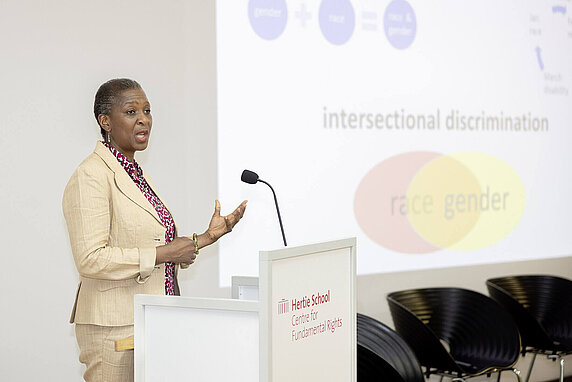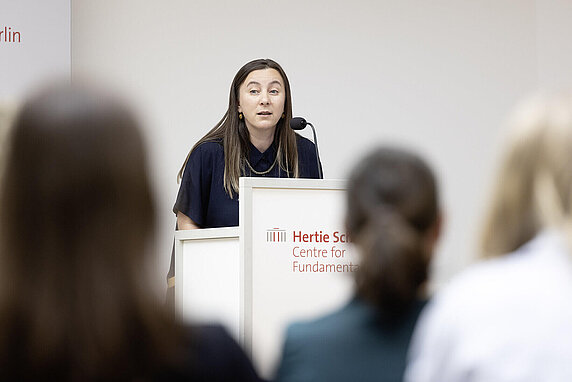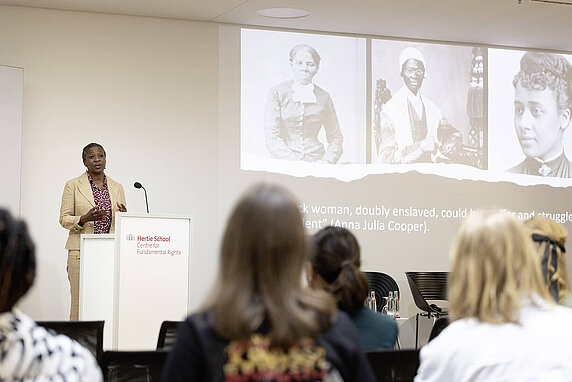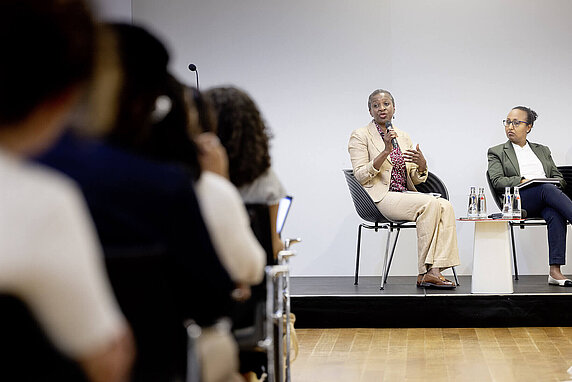Oxford Professor Iyiola Solanke visits the Hertie School as part of the CIVICA Research Excellence Tours.
On 25 May, Iyiola Solanke, Jacques Delors Professor of European Union Law at the University of Oxford and a Fellow of Somerville College, delivered a lecture titled “Centering Black women in EU anti-discrimination law” as part of the CIVICA Research Excellence Tours at the Hertie School. The lecture was followed by a discussion that included Awet Tesfaiesus, the first Black female member of the German Bundestag (Green Party) and member of the Bundestag’s Legal Committee; Elisabeth Kaneza, a legal and political scholar at the German Centre for Integration and Migration Research (DeZIM); and Mark Dawson, Professor of European Law and Governance at the Hertie School.
The discussion was chaired by Cathryn Costello, Professor of Fundamental Rights and Co-Director of the Centre for Fundamental Rights at the Hertie School. Başak Çalı, Professor of International Law and second Co-Director of the centre, made introductory remarks.
Approaching discrimination through an intersectional lens in Europe
Solanke opened her talk by contrasting the concepts of “intersectionality”, “multiple discrimination” and “intersectional discrimination”, referencing Kimberlé Crenshaw’s ground-breaking work on the issues. While multiple discrimination, as used in law, refers to a scenario where an individual facing both race and gender discrimination must establish the existence of each form of discrimination separately, intersectional discrimination emphasises the synergy between different characteristics protected under anti-discrimination law. Discrimination is more than the sum of its parts: a Black woman might experience discrimination that is different from both the discrimination a white woman experiences and the discrimination a Black man experiences. “Intersectional discrimination seeks to highlight the structural embeddedness of discrimination,” she emphasised.
Elisabeth Kaneza added, “If we were to ask if women are protected against discrimination, the answer would be ‘yes’. If we were to ask if a Black person who happens to be a woman is protected against discrimination, the answer would also be ‘yes’. If we were to ask if Black women as subjects are protected against intersectional discrimination, I’m afraid that the answer will be ‘not yet’.”
Without recognition of race, intersectional discrimination fails to protect the group for which it was created, Solanke stressed. In various countries across Europe, including Germany, legislators are working to remove the word “race” from law. Solanke argued that, if successful, this would create a situation in which Black women and individuals of colour no longer have the necessary vocabulary to talk about their experiences. “We would have racism without race,” Kaneza pointed out.
Awet Tesfaiesus, for her part, pointed out that the term “Rasse” in German is not the same as the English term “race”, and that Black Germans would never use this word to describe their racial identity. In response to concerns that removing “Rasse” from Art. 3 of the German Basic Law would open a legal void, she stressed that the term would be replaced with “racial discrimination”.
For Solanke, it is important to ensure that the qualitative difference made by intersectional discrimination is recognised in equality law. Her goal moving forward is to stress the intellectual legacy within which intersectional discrimination is anchored and to highlight the intellectual heritage of enslaved Black women and Black women post-slavery.
Re-centring Black women in anti-discrimination law
In her lecture, Professor Solanke offered an answer to the question: How do we re-centre Black women in intersectional discrimination and EU law? Among other steps, she suggested redesigning the idea of anti-discrimination law around her theory of “discrimination as stigma”. Traditionally, categories of discrimination that are banned in legal spaces are characteristics that society tends to see as “cannot be changed” or “immutable”, such as skin colour and gender, explained Solanke. In her view, this is problematic and limiting. A focus on stigma, she argued, emphasises the meaning given to the attribute rather than the attribute itself. Focussing on qualitative experiences allows us to think about different ways in which stigmas exist and operate.
Solanke also suggests taking a broader approach to anti-discrimination law. Rather than individuals seeking justice for themselves in court, a process that is draining and often financially burdening, we should think of discrimination as more of a public health issue: all of society has a responsibility to tackle it and can do so from multiple angles. Solanke stresses that by re-positioning and taking a broader approach to anti-discrimination law, we can take the burden off Black women and share the responsibility for ending discrimination.
The actions to re-centre Black women in anti-discrimination law will not only benefit Black women, says Solanke. “By centring Black women, my hope is to improve the vision and impact of anti-discrimination law to make it more effective in securing substantive equality for everyone.”
Watch the recording of the event:
A similar version of this article was first published on the CIVICA website.
This event was part of the CIVICA Research Excellence Tours which has received funding from the European Union’s Horizon 2020 research and innovation programme under grant agreement No. 101017201. It was part of the Distinguished Lectures event series hosted by the Centre for Fundamental Rights and was co-hosted with the Hertie School's Jacques Delors Centre.









